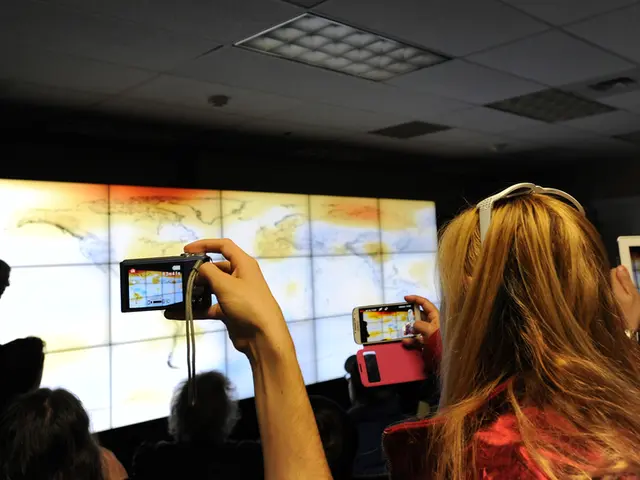Regime's Digital Iron Curtain: Smartphones in North Korea, Even the Autocorrect is Propaganda
By John Doe
Censored Mobile Devices in North Korea: Propagandized Predictions Including Autocorrect Functionality - Censored Mobile Devices in North Korea: Even the Spell-Correction Feature Promotes Government-Approved Messaging
Sure, let's dive into the mysterious world of smartphones in one of the world's most isolated nations - North Korea. While the country might be known for its dictators and military parades, it's time we talk about those pocket-sized communicators that have found their way there. But as a report by the "BBC" reveals, North Korean smartphones work quite differently from their counterparts across the globe.
The BBC recently received a North Korean smartphone smuggled out of the country last year. At first glance, it appears to be a regular Android device, resembling models by Huawei or its subsidiary Honor. But scratch the surface, and you'll find that the operating system is riddled with indications of the regime's grip on everyday life.
Home Screen Takeover
The home screen tells the tale - instead of a Google logo, the North Korean flag is displayed. The device can connect to mobile networks, but open access to the internet is not granted; only a heavily restricted selection of sites directly operated by North Korea are available.
However, the state views privacy as a luxury it cannot afford. A folder on the home screen is filled with screenshots the device takes automatically every five minutes, a feature that users cannot delete or even open. As the reporter notes, "only the authorities can."
Autocorrect as Propaganda
One of the most peculiar features is the autocorrect function. In the Korean youth slang context, the South Korean term "Oppa" is a term for a male romantic partner. But type it on a North Korean smartphone, and it will automatically be corrected to "Comrade" - accompanied by a warning that the term should not be used. South Korea, too, cannot be typed - instead, "puppet state" is the suggested term.
Under the Watchful Eye
Reports by the human rights organization Lumen in 2022 have hinted at smartphone surveillance. Not only are unauthorized files blocked, but the attempt to open them is also recorded, a practice that could potentially be used as evidence during inspections.
These measures are probably a response to efforts by South Korea and the West to inform North Koreans about life in freer societies. Independent media is often smuggled into the country, sometimes concealed in balloons carrying USB sticks, and shows like "Friends" are reportedly popular, despite their illegal status.
Tech-Savvy Rebels
Some North Koreans may see these measures as a challenge. According to Lumen, there are individuals who use so-called root access to hack the systems of their smartphones and remove the restrictions.
Although the number of tech-savvy North Koreans manipulating their smartphones might be small, Lumen believes the necessary technical knowledge is not widespread. Nevertheless, the movement appears to be large enough that even the Kim regime has reacted. A law passed in 2020 explicitly prohibits manipulating smartphone software to deactivate the security functions.
"The existence of this very specific phrasing indicates that it's happening to an extent that authorities are taking notice," believes Lumen. "And they might even be concerned about it."
Sources:
- BBC
- Lumen Report
Key Terms:
- North Korea
- Smartphone
- Kim Jong-un
Additional Insights:
- Autocorrect Features: North Korean smartphones are programmed with autocorrect features that replace certain words to align with the state's ideology. For example, the South Korean term "oppa" is automatically changed to "comrade," and any reference to "South Korea" is altered to "puppet state" to reinforce the regime's portrayal of South Korea as an American-controlled entity (1)(2)(3).
- Internet Access Restrictions: North Korean smartphones do not have access to the global internet, severely limiting the exposure to foreign information and ideas. This ensures that citizens are primarily exposed to state-approved content, which is designed to promote the regime's ideology and propaganda (1)(3)(4).
- Surveillance and Monitoring: The smartphones are equipped with a feature that captures screenshots every five minutes, storing them in a folder inaccessible to users. Only state officials can access these files, allowing them to monitor and control user behavior without their knowledge (1)(2)(4).
- Device Regulation: Phones are sealed to prevent modifications, ensuring that users can only access state-approved content and communications. The government also conducts on-the-spot inspections using "youth crackdown squads" to enforce these restrictions (3)(4).
- Propaganda Objectives:
- Cultural Influence Suppression: The regime aims to suppress South Korean cultural influence, which it views as ideologically subversive. By controlling language and content, the government can limit the spread of foreign cultural norms and ideas (1)(4).
- Ideological Conformity: The autocorrect features and surveillance help reinforce ideological conformity by ensuring that citizens use language and engage with content that aligns with the regime's propaganda and ideology (2)(3).
- Despite the digital iron curtain surrounding North Korea, tech-savvy rebels have found ways to manipulate their smartphones' software, prompting the Kim regime to enact a law prohibiting such actions.
- In North Korea, where privacy is a luxury, smartphones are outfitted with an autocorrect system that mimics the state's ideology, replacing words like "oppa" and "South Korea" with terms like "comrade" and "puppet state."
- While smartphones in North Korea resemble their global counterparts in design, the operating systems are heavily ensnared in the regime's grip, with limited internet access, automatic screenshot captures, and access restricted to state-approved content.







